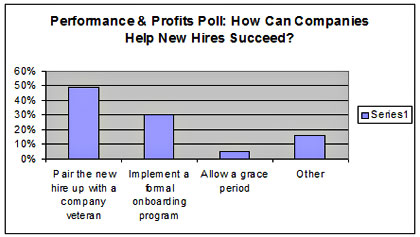By David Lee
An investment in effective onboarding is an investment in employee retention, morale, and productivity. Both research and common sense tell us that it makes sense to invest time and effort into preparing employees to be successful at their jobs. If you want them to become productive as quickly as possible, why would anyone not do what it took to make that happen? If you're going to spend all that money on acquiring them and paying them to come to work, why would you not prepare them to succeed? Despite the obviousness of this, many organizations approach new hire orientation with a level of professionalism and quality they would never tolerate in their daily operations.

Are you making these four common—and costly—mistakes in your on-boarding program?
Mistake #1: Trying to cram 20 hours worth of information into four mind-numbing hours of orientation.
From a purely practical point of view, doing this wastes your time and your hire's. If it's impossible for them to absorb the information, why spend precious time on this exercise in futility? Smart organizations break orientation into "bite-sized chunks." They also select the most effective medium for the particular type of information, off-loading information that is best accessed on one's own onto the corporate intranet.
Mistake #2: Running a slipshod, "fly by the seat of your pants" program, believing that doing so has no negative impact.
If you run a slipshod, disorganized, second-rate orientation program, you are sending the message that you're a slipshod, second-rate company. Harsh as that may sound, that's the message such programs send. While all operational decisions and practices can impact an employee's assessment of the overall intelligence, professionalism, and effectiveness of their employer, few moments of truth are as sensitive to interpretation as the onboarding process. There are several psychological reasons for this sensitivity.
Human beings are "meaning-making creatures." One of the most fundamental human drives is the need to make sense out of our world. Few experiences create greater anxiety than not understanding what is going on or why something is happening.
This need to understand and explain to ourselves what is happening and why it's happening is most powerful when we find ourselves in uncharted territory. In unfamiliar situations, especially those that are ambiguous— that is, where we're not sure what is going on and no one is guiding us— we feel vulnerable. When we feel vulnerable, we feel insecure. In this emotional state, we are especially sensitive to any clues—real or imagined— that will help us make sense of our situation. Hungry for clues and information that we can use to make sense of this new environment, we are more likely to come to hasty conclusions, based on minimal information.
Cognitive psychologists call this making a "premature cognitive commitment." Premature cognitive commitments — coming to a conclusion without getting enough facts to make a truly accurate impression — also leads one to achieve a false sense of closure and certainty. Once someone has arrived at an assessment about a person or situation, future data is unlikely to shake his or her "understanding." (Thus, the truism: "You never get a second chance to make a first impression.")
Because new hires find themselves in uncharted territory, they are more prone to grasping for any possible clue to help them understand their new environment. Thus, they are more likely to "make meaning" out of anything and everything their new employer does or doesn't do. New hires will more likely place greater significance on any displays of slipshod, disorganized, or poorly thought-out on-boarding. Because of their vulnerability to premature cognitive commitments, they are more likely to take these perceptions as indicators of the company as a whole. Those first impressions can and will taint their future perspectives on the employer.
Mistake #3: Making your new hire orientations as dull as watching paint dry.
Despite all the information available on creative training techniques, interactive exercises and games, many organizations still insist on putting new hires through coma-inducing data dumps and form-filling marathons. Orientation programs that have filling out forms, speakers droning on about various policies, and watching the obligatory sexual harassment video as their centerpieces neglect one of the most important roles of new hire orientation: creating an inspiring experience that reassures new hires they made the right choice and lays the foundation for high employee engagement.
Mistake #4: Using the "sink or swim" approach to on-boarding.
Throwing a new employee into the fray without appropriate support and coaching is one of the most common, and damaging, mistakes an organization can make. Not only does it dramatically increase the odds the employee will leave, it communicates to all employees two morale and pride damaging messages: "Management doesn't care about their people" and "Management doesn't have common sense."
Effective on-boarding means keeping in touch with your new hires as they integrate into your organization. It means actively seeking them out to find out how they're doing and—this point is critical—making it easy for them to tell HR and their boss what's on their mind. Even assertive individuals can be reluctant to ask questions or say "the way you do this isn't working."
The more safe and easy you make it for new employees to speak the truth, the more likely you are to prevent employees from waiting until their exit interview—90 days into their job—to tell you what went wrong.
Reprinted with permission from ERE Media (www.ere.net).
About the Author(s)
David Lee is the founder of http://www.humannatureatwork.com/ and an internationally recognized authority on optimizing employee performance. He is the author of Managing Employee Stress and Safety as well as dozens of articles.